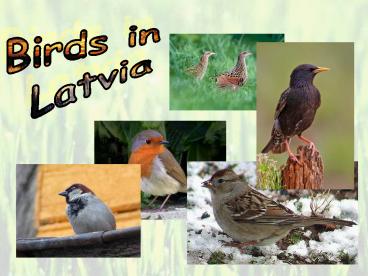Birds in - PowerPoint PPT Presentation
1 / 6
Title:
Birds in
Description:
Birds in. Latvia. chaffinch. white heron. lapwing. redbreast. woodlark. sea mew. skylark. swan ... The black stork is a large black bird with a white belly. ... – PowerPoint PPT presentation
Number of Views:67
Avg rating:3.0/5.0
Title: Birds in
1
Birds in Latvia
2
lapwing
redbreast
white heron
woodlark
chaffinch
3
skylark
sea mew
swan
woodpecker
4
Black Stork
The black stork is a large black bird with a
white belly. In size it is slightly smaller than
the common white stork. It is found in all
regions of Latvia, though their distribution is
uneven. Approximately 10 of the world's black
stork population nests in Latvia (about 1,000
pairs). The black stork nests in secluded places,
such as in old forests near lakes, rivers, and
mires. For its large nest it needs large trees
with thick branches - old pines, aspens, oaks,
ashes, and birches. In this year Black Stork is
annual bird in Latvia.
5
This large, noble bird is considered sacred by
Latvians and many other nationalities. Almost at
every third farm house a pair can be found
nesting. Often the stork is enticed to a house by
hoisting a wheel on top of a pole to supply the
foundation for a nest. Many beliefs are
associated with storks for example, the house
where a stork lives has good fortune a stork
protects the home from fire if a stork's nest is
destroyed, the house burns down and, of course,
a stork brings babies. The white stork, unlike
the black, is not afraid of people. It boldly
walks behind a mower in quest of frogs or lizards
cut by the mower. Approximately 10,000 pairs of
white storks nest in Latvia (in 1934 there were
7,000 pairs) - that is, one pair per 250
inhabitants that is why Latvia can be called the
land of storks. In some places storks live in
huge colonies and walk en masse through
neighbouring fields.
White Stork
6
Corncrake
The corncrake is slightly larger than the thrush.
Its plumage is yellowish-brown, its wings are
reddish-brown with chestnut brown stripes on the
wings and under the tail. The bird runs quickly
and hides in the grass. Because it is so rarely
seen, there is a widespread misconception that it
journeys on foot to its wintering places in
Mediterranean countries or Africa. Actually, the
corncrake migrates in the usual way, but it flies
only at night. The corncrake signals its presence
by its characteristic cry - the oft-repeated
"creck-creck" - which is rather common in the
Latvian countryside. According to some sources,
from 26,000 to 38,000 corncrake pairs nest in
Latvia. In other European countries the corncrake
is rare because of intensive farming and
environmental pollution.































